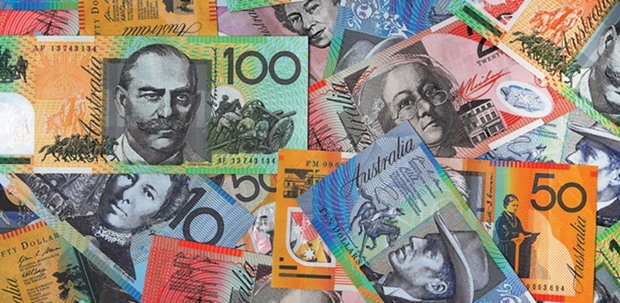The Australian dollar is poised for its best month since October 2011 but the currency’s momentum isn’t strong enough to budge the world’s biggest fund manager.
BlackRock’s Sydney-based head of fixed income for Australia Stephen Miller - who started avoiding the Aussie as it peaked in 2011 and picked its 2008 nadir - is sticking with a bearish call he’s maintained for about three years. He sees the Aussie plunging at least 14% back past the seven-year low it hit in January. That contrasts with hedge funds and other large speculators whose bullish positions earlier in March reached the most in 18 months, with the currency gaining 6.5% since February 29.
“The Aussie dollar is a volatile currency, it’s sometimes a case of five steps down and two steps up,” said Miller. “We’re in the two steps up phase and the next phase will be the five steps down phase.” Miller is sceptical about signs that the local economy may have turned a corner after absorbing the shock of slumping mining investment and commodity prices.
While gross domestic product recorded its fastest annual growth in about two years in 2015, consumer confidence has fallen in three of the past four months and median house prices in Sydney dropped in February by the most since at least 1990.
Traders see a strong chance the central bank will lower its record-low benchmark interest rate over a year and only six of more than 50 economists predict the currency will gain from current levels by December 31.
The Aussie fell to 75.75 US cents in Sydney yesterday after reaching an eight-month high of 76.80 on Friday. Its current level is significantly below the $1.1081 it peaked at in 2011 after plummeting over the past three years to touch 68.27 cents on January 15.
Miller predicts the currency will fall to 65 cents and probably lower by the end of this year, more bearish than the median forecast for it to end 2016 at 70 cents.
Australia’s economy grew faster than forecast in the final three months of last year, prompting investors to pare bets on monetary easing and making the local currency one of the chief beneficiaries of recent weakness in the greenback.
The expansion in gross domestic product was driven by household spending and increased home building while employers added the most jobs on record in the final quarter as industries including tourism and education capitalised on a lower currency and weak wage growth.
For Miller, the trend in GDP growth for 2016 and beyond is probably close to 2% than to the 3% recorded last year. Activity will be curtailed by declines in capital spending and a softening in residential construction, which will eventually take a toll on housing turnover and consumer spending, he said.
Growth at that level “will open the door for rate cuts and, if it opens the door for rate cuts, that opens the door for a lower Aussie dollar,” he said. “Over time, albeit in a fairly volatile fashion, we’ll still get to the mid- to-low 60s level by the end of this year.”
Miller’s concerns are borne out in the swaps market, where traders are seeing a better than 90% chance the central bank will lower its benchmark rate to 1.75% from an already record-low 2% over 12 months.
Currency traders have recently brushed these concerns aside, focusing instead on the higher yields on offer in Australia as central banks in Europe and Japan ease policy and the Federal Reserve appears reluctant to increase rates.
Net bullish futures bets on the Aussie dollar climbed to 29,195 in the week to March 8, the most since September 2014, data from the Commodity Futures Trading Commission show. They dropped to 12,782 a week later, in the run-up to the last Fed meeting.
The currency can climb to 80 cents over three months because of the US’s dovish policy stance, Macquarie Bank said in a research report March 17. Those gains won’t last as the Australian economy needs a weaker currency to adjust to the end of a mining investment boom, wrote analysts led by Nizam Idris, Singapore-based head of foreign-exchange and fixed-income strategy.

Australian dollar banknotes of various denominations are arranged for a photograph in Sydney. BlackRock’s Miller predicts the currency will fall to 65 cents and probably lower by the end of this year, more bearish than the median forecast for it to end 2016 at 70 cents.
